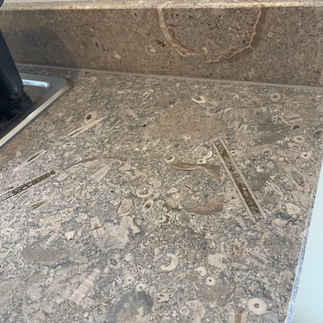Doing some renovations on our family home, my mum was set with the task of choosing a stone for the counter tops in our kitchen. Having lots of family ties to Derbyshire and the peak district she began looking for some quarries in the area and came across the Once-a-week quarry in Sheldon, just outside Bakewell which produces the gorgeous, fossil-filled Mandale Limestone.
Photos of our kitchen counter including a lovely patch of sponge by the cooker (middle photo) and many crinoids.
This limestone is packed full of fossils, crinoids mostly but also brachiopods and the occasional sponges. They make for a stunning counter top and a great talking piece when guests come over.

A photo of Once-a-week quarry, Derbyshire
A couple of weeks ago, my boyfriend and I went on a little camping trip and by coincidence found oursleves about a 2 minute drive from the quarry. After contacting the people running the quarry (don't go into quarries without supervision and safety equipment they can be extremely dangerous) we were told that they were not operating on the day we were visiting but a public foot path takes you very close to the quarry so we could go and have a look.
It was indeed about a 10 minute walk on the footpath from the side of the road to the quarry and when we got there it was stunning. Well, stunning in the way any quarry is. It was not particulrly big or impressive but you could see from even far away the offcuts were all packed full with fossils. We even came across some bits of rock with crinoids up to about 4cm in diameter! It was very cool to go and see the rocks now making up our kitchen surfaces actually in -situ and safe to say mum was pretty jealous.

Me standing on the footpath next to the quarry.
What are the fossils?
The fossiliferous (filled with fossils) limestone from this quarry formed during the Carboniferous period about 355 million years ago. The fossils found in it would have been living on the floor of a warm, shallow sea and once they died they were compacted down into the limestone they form today. The limestone was then brought up due to tectonic forces to form the hills of Derbyshire.
The most abundant fossils in the rock are crinoids. Crinoids, often called sea lillies, are an animal that looked very much like a plant. They were attached to the sea floor by a stem and fed by filtering our plankton from the water passing by them using feather like arms. In the limestone itself you can see lots of crinoid ossicles (individual disc like plates that make up the stem).
Left to right: Crinoid ossicles we collected form near the quarry, crinoid ossicles in situ in the limestone, slabs of offcuts near the quarry.
Shelly fossils were also found, mostly brachiopod shells. Brachiopods are organisms that have two shells that are attached at a hinge and open and close.
The occasional sponge and coral can also be seen in the limestone and some sources say you can even find the odd sharks tooth!
Why is it called once-a-week quarry?
The quarry got its name from the fact that it was the only quarry in the area to pay its workers once a week rather than once a fortnight back in the early 1900s. The quarrying today is still done using traditional methods, without any explosives, in order to preserve the environment of the local area.
Find out more: http://mandalelimestone.com/quarry/












Comentarios